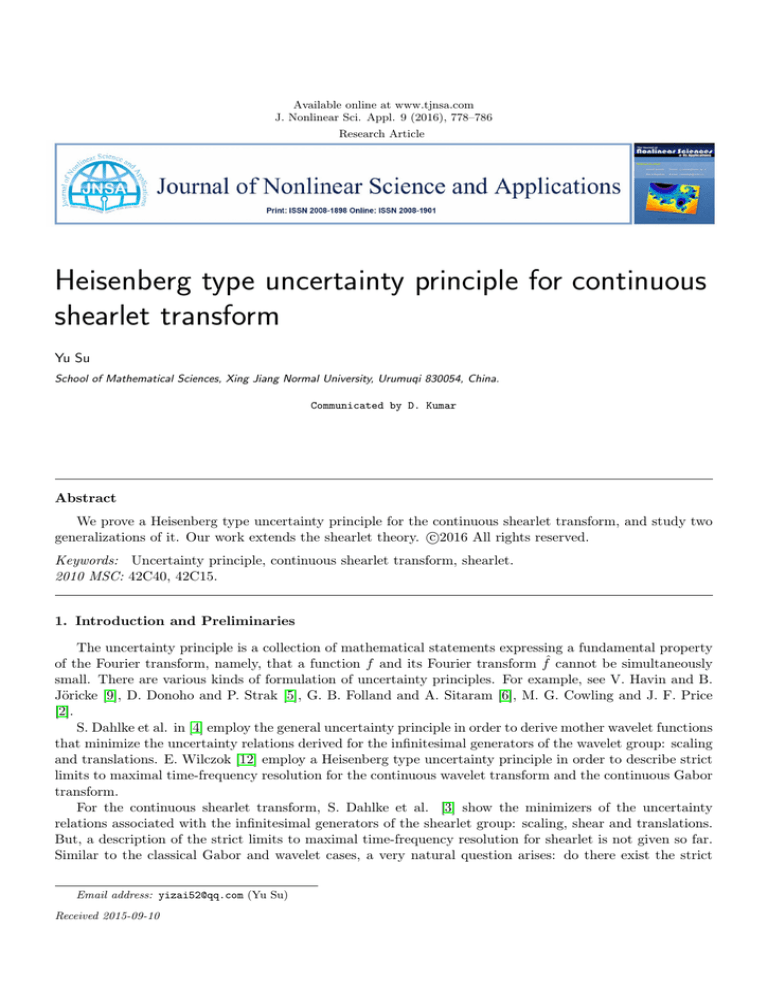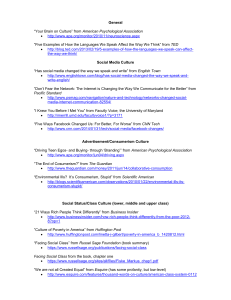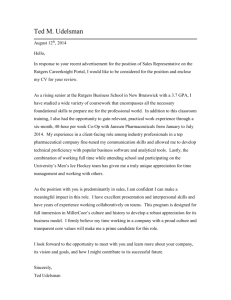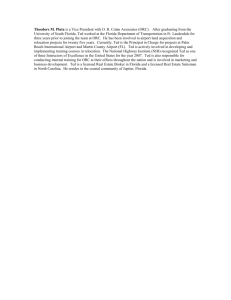
Available online at www.tjnsa.com
J. Nonlinear Sci. Appl. 9 (2016), 778–786
Research Article
Heisenberg type uncertainty principle for continuous
shearlet transform
Yu Su
School of Mathematical Sciences, Xing Jiang Normal University, Urumuqi 830054, China.
Communicated by D. Kumar
Abstract
We prove a Heisenberg type uncertainty principle for the continuous shearlet transform, and study two
c
generalizations of it. Our work extends the shearlet theory. 2016
All rights reserved.
Keywords: Uncertainty principle, continuous shearlet transform, shearlet.
2010 MSC: 42C40, 42C15.
1. Introduction and Preliminaries
The uncertainty principle is a collection of mathematical statements expressing a fundamental property
of the Fourier transform, namely, that a function f and its Fourier transform fˆ cannot be simultaneously
small. There are various kinds of formulation of uncertainty principles. For example, see V. Havin and B.
Jöricke [9], D. Donoho and P. Strak [5], G. B. Folland and A. Sitaram [6], M. G. Cowling and J. F. Price
[2].
S. Dahlke et al. in [4] employ the general uncertainty principle in order to derive mother wavelet functions
that minimize the uncertainty relations derived for the infinitesimal generators of the wavelet group: scaling
and translations. E. Wilczok [12] employ a Heisenberg type uncertainty principle in order to describe strict
limits to maximal time-frequency resolution for the continuous wavelet transform and the continuous Gabor
transform.
For the continuous shearlet transform, S. Dahlke et al. [3] show the minimizers of the uncertainty
relations associated with the infinitesimal generators of the shearlet group: scaling, shear and translations.
But, a description of the strict limits to maximal time-frequency resolution for shearlet is not given so far.
Similar to the classical Gabor and wavelet cases, a very natural question arises: do there exist the strict
Email address: yizai52@qq.com (Yu Su)
Received 2015-09-10
Y. Su, J. Nonlinear Sci. Appl. 9 (2016), 778–786
779
limits to maximal time-frequency resolution related to the continuous shearlet transform? The answer is yes,
since, K. Gröchenig has given a very important meta-uncertainty principle for time-frequency representation
in [7].
Metatheorem: Every time-frequency representation comes with its own version of the
uncertainty principle.
The shearlet transform [1, 8, 10, 11] has an advance over the classical wavelet transform as it provides
information about the directionality within the image. One of the main problems in shearlet theory is the
Heisenberg type uncertainty principle for the continuous shearlet transform.
In this paper, we present a recipe to derive a Heisenberg type uncertainty principle for the continuous
shearlet transform.
1. Define a continuous shearlet transform, and choose a Heisenberg type uncertainty principle.
2. Replace the function f and fˆ in the uncertainty principle by the continuous shearlet transform, and
formulate a new uncertainty principle.
3. Prove the resulting inequality.
Many ideas in this paper are inspired by S. Dahlke et al. [3], E. Wilczok [12], M. G. Cowling et al. [2]
and K. Gröchenig [7]. Our work extends shearlet theory.
The paper is organized as follows: in Section 2, we give some notation and definitions. Then in Section 3,
we prove some lemmas on shearlet. In Section 4, we prove a Heisenberg type uncertainty principle for the
continuous shearlet transform, and then we study two generalizations of it.
2. Preliminary
We will use the following conventions throughout the paper. For a function f ∈ L1 (R2 ) ∩ L2 (R2 ), the
Fourier transform of f is defined by
Z
ˆ
F(f )(ξ) = f (ξ) = f (x)e−2πiξ·x dx.
R2
a o
√
and Ss =
0
a
the dilation operator
Set Aa =
1 s
. We introduce the following fundamental operators of shearlet:
0 1
1
[DAa ψ](x) = | det Aa |− 2 ψ(A−1
a x)
a ∈ R+ , ψ ∈ L2 (R2 ),
the shear operator
[DSs ψ](x) = ψ(Ss−1 x)
s ∈ R, ψ ∈ L2 (R2 )
and the translation operator
t ∈ R2 , ψ ∈ L2 (R2 ).
[Tt ψ](x) = ψ(x − t)
Definition 2.1. Let ψ ∈ L2 (R2 ); shearlet for a ∈ R+ , s ∈ R, t ∈ R2 is defined by
1
−1
ψa,s,t (x) = det |Aa |− 2 ψ(A−1
a Ss (x − t)).
The shearlet system generated by ψ is defined by {ψa,s,t (x) : a ∈ R+ , s ∈ R, t ∈ R2 }.
The associated continuous shearlet transform of an f ∈ L2 (R2 ) is given by
Z
SHψ f (a, s, t) = hf, ψa,s,t i = f (x)ψa,s,t (x)dx.
R2
We denote the norm on
Lp (R2 )
by
1
Z
kf kp =
p
p
|f (x)| dx .
R2
For an f ∈
L2 (R2 )\{0},
the Heisenberg–Pauli–Weyl inequality is
(2.1)
Y. Su, J. Nonlinear Sci. Appl. 9 (2016), 778–786
780
1
1
2
2
Z
Z
1
2
2
2
2
x |f (x)| dx ξ |fˆ(ξ)| dξ ≥
|f (x)|2 dx,
2
Z
R2
R2
R2
which is generalized in [2] as
1
1
p
p
Z
Z
Z
p
p
p
p
x |f (x)| dx ξ |fˆ(ξ)| dξ ≥ 1 |f (x)|2 dx.
2
R2
R2
R2
3. Notation
Before entering derivation of uncertainty principle for continuous shearlet transform, we prove four
lemmas about its properties.
Lemma 3.1. Let f, ψ ∈ L2 (R2 ); then
1
fˆ(ξ)ψ̂(ξSs Aa ) = det |Aa |− 2 Ft (SHψ f (a, s, t)),
where a ∈ R+ , s ∈ R, t ∈ R2 .
Proof. In fact, we have
1
ψ̂a,s,t (ξ) = det |Aa |− 2
1
Z
ZR
= det |Aa | 2
−1
−2πiξx
ψ(A−1
dx
a Ss (x − t))e
2
ψ(y)e−2πiξ(Ss Aa y+t) dy,
−1
Let y = A−1
a Ss (x − t)
R2
1
2
= det |Aa | ψ̂(ξSs Aa )e−2πiξt .
Then, we obtain
Z
SHψ f (a, s, t) =
f (x)ψa,s,t (x)dx
R2
Z
=
fˆ(ξ)ψ̂a,s,t (ξ)dξ
P lanchel T heorem
R2
Z
=
1
fˆ(ξ)det |Aa | 2 ψ̂(ξSs Aa )e−2πiξt dξ
R2
= det |Aa |
1
2
Z
fˆ(ξ)ψ̂(ξSs Aa )e2πiξt dξ
R2
1
2
= det |Aa | F −1 (fˆ(ξ)ψ̂(ξSs Aa ))(t).
A direct calculation yields
1
det |Aa | 2 F −1 (fˆ(ξ)ψ̂(ξSs Aa ))(t) = SHψ f (a, s, t)
1
F −1 (fˆ(ξ)ψ̂(ξSs Aa ))(t) = det |Aa |− 2 SHψ f (a, s, t)
1
fˆ(ξ)ψ̂(ξSs Aa ) = det |Aa |− 2 Ft (SHψ f (a, s, t)),
where Ft denotes the Fourier transform with respect to the variable t.
(3.1)
Y. Su, J. Nonlinear Sci. Appl. 9 (2016), 778–786
781
Lemma 3.2. Let f, ψ ∈ L2 (R2 ); then
Z
Z
2
|Ft (SHψ f (a, s, t))(ξ)| dξ = |SHψ f (a, s, t))|2 dt,
R2
R2
where a ∈ R+ , s ∈ R, t ∈ R2 .
By using the Plancherel theorem, Lemma 3.2 could be proved.
Definition 3.3. Let ψ ∈ L2 (R2 ) be such that
Z Z
|ψ̂(ξx , ξy )|2
Cψ =
dξx dξy < ∞
ξx2
R R
is satisfied. Then ψ is admissible.
We need the following form of the admissibility condition.
Lemma 3.4. Let ψ ∈ L2 (R2 ) and ψ be admissible. Then
Z Z
|ψ̂(ξSs Aa )|2
dads = Cψ < ∞
3
a2
(3.2)
R R
is satisfied.
Proof. In fact, we have
Z Z
|ψ̂(ξSs Aa )|2
3
R R
Z Z
dads =
a2
|ψ̂(aξx ,
√
aξy )|2
3
dads
q
√
Z Z |ψ̂(νx , νx ξx s + νx ξy )|2
ξx
dν
x
3
( νξxx ) 2
R R
=
√
a2
R R
=
asξx +
ξx
q
1
√
Z Z |ψ̂(νx , νx ξx s + νx ξy )|2 ξx2
ξx
3
νx 2
R R
ds
dνx ds
1
Z Z
=
|ψ̂(νx , νy )|2 ξx2
3
x2
ν
R R
Z Z
=
dνy
dνx √
νx ξx
|ψ̂(νx , νy )|2
dνx dνy = Cψ .
νx 2
R R
Since ψ is admissible, we obtain
Z Z
|ψ̂(ξSs Aa )|2
3
R R
a2
dads = Cψ < ∞.
The admissibility condition for the continuous shearlet transform is given by the following lemma.
Lemma 3.5 ([3]). Let f, ψ ∈ L2 (R2 ); then
Z Z Z
dadsdt
|SHψ f (a, s, t)|2
= Cψ kf k2L2 (R2 ) ,
a3
R2 R R
where a ∈ R+ , s ∈ R, t ∈ R2 .
(3.3)
Y. Su, J. Nonlinear Sci. Appl. 9 (2016), 778–786
782
4. Uncertainty principle of Heisenberg type for continuous shearlet transform
We will prove the main results of our paper in this section.
Theorem 4.1. Let ψ ∈ L2 (R2 ); then for arbitrary f ∈ L2 (R2 )\{0}, we have
1
1
p
2
2
Z
Cψ
2 ˆ
2
2
2 dadsdt
ξ |f (ξ)| dξ
t |SHψ f (a, s, t)|
≥
kf k2L2 (R2 ) .
3
a
2
Z Z Z
R2 R R+
R2
Proof. We get from admissibility condition (3.2) for ψ
Z
Z Z
Z
Z Z Z
dads
2 ˆ
2
2 dads
2 ˆ
2
Cψ ξ |f (ξ)| dξ =
|ψ̂(ξSs Aa )|
ξ |f (ξ)| dξ =
ξ 2 |fˆ(ξ)|2 |ψ̂(ξSs Aa )|2 3 dξ.
3
a2 2
a2
+
+
2
2
R R
R
R
R
R R
Put formula (3.1) into above equation and get
Z
Z Z Z
dads
Cψ ξ 2 |fˆ(ξ)|2 dξ = det |Aa |−1
ξ 2 |Ft [SHψ f (a, s, t)](ξ)|2 3 dξ
a2
R2
R2 R R+
Z Z Z
dads
=
ξ 2 |Ft [SHψ f (a, s, t)](ξ)|2 3 dξ.
a
R2 R R+
The Heisenberg–Pauli–Weyl inequality leads to
1
1
2
2
Z
Z
Z
2
2
2
2
t |SHψ f (a, s, t)| dt ξ |Ft [SHψ f (a, s, t)](ξ)| dξ ≥ 1 |SHψ f (a, s, t)|2 dt
2
R2
R2
R2
for all a ∈ R+ . Integrating with respect to dads
, we obtain
a3
1
1
2
2
Z
Z Z
Z
2
2 dads
2
2
ξ |Ft [SHψ f (a, s, t)](ξ)| dξ
t |SHψ f (a, s, t)| dt
3
a
R R+
R2
R2
≥
Z Z Z
1
2
|SHψ f (a, s, t)|2
dadsst
.
a3
R2 R R+
The right-hand side of the above inequality can be rewritten as Cψ kf k2L2 (R2 ) . Therefore, we get
1
1
2
2
Z
Z Z Z
p
2
2 dadsdt
2 ˆ
2
t |SHψ f (a, s, t)|
Cψ
ξ |f (ξ)| dξ
a3
R2 R R+
R2
1
Z Z Z
=
R2 R R+
2
t
dadsdt
|SHψ f (a, s, t)|2
a3
2
1
Z
Cψ
2
ξ |fˆ(ξ)|2 dξ
2
R2
1
1
2
2
Z Z Z
Z Z Z
dadsdt
dadsdξ
2
2
2
2
=
t |SHψ f (a, s, t)|
ξ |Ft [SHψ f (a, s, t)](ξ)|
a3
a3
R2 R R+
R2 R R+
Z Z Z
dadsdt
1
1
≥
|SHψ f (a, s, t)|2
= Cψ kf k2L2 (R2 ) .
2
a3
2
R2 R R+
(4.1)
Y. Su, J. Nonlinear Sci. Appl. 9 (2016), 778–786
783
From the above inequality, we have
1
1
2
2
Z Z Z
Z
p
1
2
2 dadsdt
2 ˆ
2
≥ Cψ kf k2L2 (R2 ) ,
t |SHψ f (a, s, t)|
Cψ
ξ |f (ξ)| dξ
3
a
2
R2 R R+
R2
1
1
p
2
2
Z
Z Z Z
Cψ
dadsdt
2
2
2
2
ˆ
ξ |f (ξ)| dξ ≥
t |SHψ f (a, s, t)|
kf k2L2 (R2 ) .
3
a
2
R2 R R+
R2
So, we obtain the Heisenberg type uncertainty principle for the continuous shearlet transform.
Theorem 4.2. Let ψ ∈ L2 (R2 ), arbitrary f ∈ L2 (R2 )\{0}, and 1 ≤ p ≤ 2, then
1
1
3p
p
p
Z Z Z
Z
a p Cψ
dadsdt
p
p
p
p
ˆ
ξ |f (ξ)| dξ ≥
t |SHψ f (a, s, t)|
kf k2L2 (R2 )
3
a3
2
2a
+
2
2
R
R R
R
Proof. We prove this theorem as follows.
p
2 Z
Z Z
Z
p
dads
2
p ˆ
p
2
|ψ̂(ξSs Aa )|
ξ |f (ξ)| dξ =
Cψ
ξ p |fˆ(ξ)|p dξ
3
a2
R +
R2
R2
Z Z RZ
dads
≥
ξ p |fˆ(ξ)|p |ψ̂(ξSs Aa )|p 3p dξ
a4
R2 R R+
Z Z Z
p
dads
= det |Aa |− 2
ξ p |Ft [SHψ f (a, s, t)](ξ)|p 3p dξ
a4
R2 R R+
Z Z Z
dads
=
ξ p |Ft [SHψ f (a, s, t)](ξ)|p 3p dξ.
a2
+
2
R
R R
The generalization of Heisenberg–Pauli–Weyl inequality in [2, Theorem 1.2] leads to
1
1
p
p
Z
Z
Z
1
p
p
p
p
t |SHψ f (a, s, t)| dt ξ |Ft [SHψ f (a, s, t)](ξ)| dξ ≥
|SHψ f (a, s, t)|2 dt.
2
R2
R2
R2
The right-hand side of the above inequality can be rewritten as Cψ kf k2L2 (R2 ) , so that we have
1 p
1
p
p
Z
Cψ
p
p dadsdt
p ˆ
p
t |SHψ f (a, s, t)|
ξ |f (ξ)| dξ
3
− 32
a3
p
a
R2 R R+
R2
1
1
p
p
p
Z Z Z
Z
2
Cψ
p
p dadsdt
p ˆ
p
=
t |SHψ f (a, s, t)|
ξ |f (ξ)| dξ
3− 3p
a3
2
a
R2 R R+
R2
1
1
p
p
Z Z Z
Z Z Z
dadsdt
dadsdξ
p
p
p
p
≥
t |SHψ f (a, s, t)|
ξ |Ft [SHψ f (a, s, t)](ξ)|
a3
a3
R2 R R+
R2 R R+
Z Z Z
dadsdt
1
1
≥
|SHψ f (a, s, t)|2
= Cψ kf k2L2 (R2 ) .
2
a3
2
Z Z Z
R2 R R+
(4.2)
Y. Su, J. Nonlinear Sci. Appl. 9 (2016), 778–786
784
From the above inequality, we get
1 p
1
p
p
Z Z Z
Z
C
dadsdt
ψ
p
p
p
p
ξ |fˆ(ξ)| dξ ≥ Cψ kf k2 2 2 ,
t |SHψ f (a, s, t)|
3
3
L (R )
−
a3
2
p
2
a
+
2
2
R R R
R
1
1
3p
p
p
Z Z Z
Z
p
a
Cψ
dadsdt
p
p
p
p
ξ |fˆ(ξ)| dξ ≥
t |SHψ f (a, s, t)|
kf k2L2 (R2 ) .
3
a3
2a 2
R2 R R+
R2
By putting p = 2 in Theorem 4.2, we get Theorem 4.1. So, Theorem 4.1 is a special case of Theorem
4.2.
Theorem 4.3. Let ψ ∈ L2 (R2 ), f ∈ L2 (R2 )\{0}, and q ≥ 2. Then
1
1
1
q
q
Z Z Z
Z
q
4
C
dadsdt
ξ q |fˆ(ξ)|2 dξ ≥ ψ kf k q 2 2
tq |SHψ f (a, s, t)|2
L (R ).
a3
2
R2 R R+
R2
Proof. By using the Hölder inequality
2
1− 2
q
q
Z Z Z
Z Z Z
q
2 dadsdt
2 dadsdt
t |SHψ f (a, s, t)|
|SHψ f (a, s, t)|
a3
a3
R2 R R+
R2 R R+
2
1− 2
q
q
ZZZ
ZZZ
q
1
4 2 dadsdt
2− 4q 1− 2q dadsdt
2
q
t |SHψ f (a, s, t)|
|SHψ f (a, s, t)|
=
a3
a3
R2 R R+
R2 R R+
Z Z Z
4
2− 4 dadsdt
≥
|(t2 SHψ f (a, s, t) q )(SHψ f (a, s, t) q )|
a3
+
2
R R R
Z Z Z
dadsdt
=
t2 |SHψ f (a, s, t)|2
,
a3
R2 R R+
we obtain
!1
2
RR R
1
q
ZZZ
dadsdt
≥
tq |SHψ f (a, s, t)|2
a3
R2R R+
t2 |SHψ f (a, s, t)|2 dadsdt
a3
! q−2 .
2q
R2 R R+
RR R
R2R R+
|SHψ f (a, s, t)|2 dadsdt
a3
Similarly, we infer from formula (3.1) that
!1
!1
2
1
q
Z
q
2
ˆ
ξ |f (ξ)| dξ ≥
R
R2
!1−1
2
R2
R
2
ξ 2 |fˆ(ξ)|2 dξ
|fˆ(ξ)|2 dξ
ξ 2 |fˆ(ξ)|2 dξ
R
=
q−2
R2
!1−
q
2
Cψ
R2
2q
1 Cψ
q
|fˆ(ξ)|2 dξ
R
R2
!1
2
R
ξ 2 |fˆ(ξ)|2 dξ
q−2
R2
=
!1−
2
R R R
R2 R R+
|Ft [SHψ f (a, s, t)](ξ)|2 dadsdξ
a3
2q
.
1 Cψ
q
(4.3)
Y. Su, J. Nonlinear Sci. Appl. 9 (2016), 778–786
785
Applying Lemma 3.2 to the above inequality, we get
!1
2
ξ 2 |fˆ(ξ)|2 dξ
R
1
q
Z
ξ q |fˆ(ξ)|2 dξ ≥
q−2
R2
!1−
2
R2
R R R
R2 R R+
2q
.
1 Cψ
(4.4)
q
|SHψ f (a, s, t)|2 dadsdt
a3
Multiplying (4.3) and (4.4), then by using formula (4.1) and (3.3), we obtain
1
1
q
q
Z Z Z
Z
q
2 dadsdt
q ˆ
2
t |SHψ f (a, s, t)|
ξ |f (ξ)| dξ
a3
R2 R R+
R2
!1
!1
2
R R R
R2 R R+
≥
2
t2 |SHψ f (a, s, t)|2 dadsdt
a3
R
ξ 2 |fˆ(ξ)|2 dξ
R2
!1− 2
q
R R R
R2 R R+
|SHψ f (a, s, t)|2 dadsdt
a3
p
Cψ kf k2L2 (R2 )
≥
q−2
!1−
2
R R R
R2 R R+
1
q−2
q−2
Cψ2q
2q
2 Cψ
q
|SHψ f (a, s, t)|2 dadsdt
a3
1
4
Cψ2 Cψ2q kf k2L2 (R2 )
Cψq
=
= kf kLq 2 (R2 ) .
1− 2
2
q
2 Cψ kf k2L2 (R2 )
Theorem 4.1 is a special case of Theorem 4.3 obtained by putting q = 2 in it.
Acknowledgement
The author is supported by the Xinjiang Normal University graduate student innovation fund project:
No.(20142006).
References
[1] B. G. Bodmann, G. Kutyniok, X. Zhuang, Gabor shearlets, Appl. Comput. Harmon. Anal., 38 (2015), 87–114. 1
[2] M. G. Cowling, J. F. Price, Bandwidth versus time concentration: the Heisenberg-Pauli-Weyl inequality, SIAM
J. Math. Anal., 15 (1984), 151–165. 1, 2, 4
[3] S. Dahlke, G. Kutyniok, P. Maass, C. Sagiv, H. G. Stark, G. Teschke, The uncertainty principle associated with
the continuous shearlet transform, Int. J. Wavelets Multiresolut. Inf. Process., 6 (2008), 157–181. 1, 3.5
[4] S. Dahlke, P. Maass, The affine uncertainty principle in one and two dimensions, Comput. Math. Appl., 30
(1995), 293–305. 1
[5] D. Donoho, P. B. Strak, Uncertainty principles and signal recovery, SIAM J. Appl. Math., 49 (1989), 906–931. 1
[6] G. B. Folland, A. Sitaram, The uncertainty principle: a mathematical survey, J. Fourier Anal. Appl., 3 (1997)
207–238. 1
[7] K. Gröchenig, Uncertainty principles for time-frequency representations, Numer. Harmon. Anal., Birkhäuser
Boston, (2003), 11–30. 1
[8] K. Guo, G. Kutyniok, D. Labate, Sparse multidimensional representations using anisotropic dilation and shear
operators; in: G. Chen, M.-J. Lai (eds.), Wavelets and splines: Athens 2005, Nashboro Press, Brentwood (2006),
189–201. 1
[9] V. Havin, B. Jöricke, The uncertainty principle in harmonic analysis, Springer-Verlag, Berlin, Heidelberg, (1995).
1
Y. Su, J. Nonlinear Sci. Appl. 9 (2016), 778–786
786
[10] D. Kumara, S. Kumarb, B. Singhd, Cone-adapted continuous shearlet transform and reconstruction formula, J.
Nonlinear Sci. Appl., 9 (2016), 262–269. 1
[11] D. Labate, W. Q. Lim, G. Kutyniok, G. Weiss, Sparse multidimensional representation using shearlets; in: M.
Papadakis, A.F. Laine, M.A. Unser (eds.), Wavelets XI. Proc. SPIE, 5914 (2005), 254–262. 1
[12] E. Wilczok, New uncertainty principles for the continuous Gabor transform and the continuous wavelet transform,
Doc. Math. J. DMV, 5 (2000), 201–226. 1







